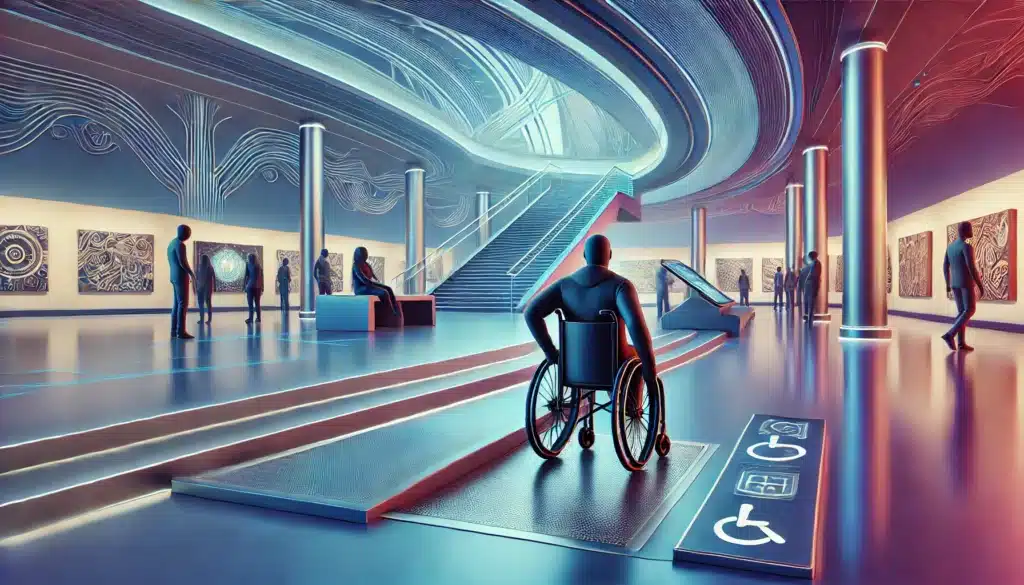Introduzione
L’accessibilità nei luoghi culturali è fondamentale per garantire che musei, gallerie e siti storici siano fruibili da tutti, indipendentemente dalle abilità fisiche o cognitive. Questo concetto va oltre l’eliminazione delle barriere architettoniche, abbracciando una visione inclusiva che considera le esigenze di ogni visitatore. Come sottolineato dall’ICOM Italia, l’accessibilità è un diritto fondamentale che promuove la partecipazione attiva alla cultura.
L’importanza dell’accessibilità culturale
L’accessibilità culturale non si limita all’accesso fisico agli edifici, ma include anche la comprensione e l’interazione con i contenuti esposti. Garantire visite al museo accessibili significa offrire esperienze che tengano conto delle diverse esigenze dei visitatori, come percorsi tattili e audioguide per non vedenti o altre soluzioni per non udenti. Questo approccio inclusivo non solo amplia il pubblico, ma arricchisce l’esperienza culturale complessiva.
Linee guida per l’eliminazione delle barriere e per favorire l’accessibilità culturale
Per affrontare le sfide legate all’accessibilità, sono state sviluppate linee guida specifiche. Ad esempio, l’ICOM Italia ha pubblicato documenti che forniscono indicazioni su come rendere musei e luoghi culturali più accessibili. Queste linee guida coprono aspetti come l’eliminazione delle barriere architettoniche, sensoriali e cognitive, promuovendo una fruizione più ampia e inclusiva.
Strategie per visite al museo accessibili
Per rendere le visite al museo più accessibili, è essenziale adottare diverse strategie:
- Formazione del personale: il personale museale dovrebbe essere formato per assistere visitatori con diverse esigenze, garantendo un’accoglienza inclusiva.
- Tecnologie assistive: l’implementazione di tecnologie come audioguide, applicazioni mobile e dispositivi interattivi può migliorare l’esperienza dei visitatori con disabilità sensoriali.
- Segnaletica chiara: una segnaletica ben progettata e facilmente comprensibile facilita l’orientamento all’interno degli spazi espositivi.
Il ruolo del PNRR nell’accessibilità culturale
Il Piano Nazionale di Ripresa e Resilienza (PNRR) rappresenta un’opportunità significativa per migliorare l’accessibilità nei luoghi culturali italiani. Questo piano prevede investimenti per eliminare le barriere architettoniche e sensoriali, promuovendo una maggiore inclusione. L’ICOM Italia ha evidenziato come il PNRR possa contribuire a rendere i musei più accessibili e accoglienti per tutti.

Esempi di buone pratiche
Diversi musei hanno già implementato iniziative per migliorare l’accessibilità:
- Museo Tattile Statale Omero: situato ad Ancona, offre percorsi tattili dedicati a visitatori non vedenti e ipovedenti, permettendo un’interazione diretta con le opere.
- Museo Egizio di Torino: ha sviluppato guide in Lingua dei Segni Italiana (LIS) per visitatori sordi, garantendo un’esperienza completa e coinvolgente.
Accessibilità culturale senza investimenti iniziali
amuseapp: un ponte verso l’accessibilità universale
Sviluppare soluzioni per migliorare l’accessibilità del proprio museo può essere costoso, ma con amuseapp è possibile farlo senza investimenti iniziali trovando la giusta soluzione per luoghi culturali di ogni dimensione.
amuseapp trasforma i luoghi culturali in spazi realmente accessibili grazie a una serie di funzionalità innovative. L’audioguida multilingue, disponibile in oltre 30 lingue, abbatte le barriere linguistiche e permette a ogni visitatore di immergersi nei contenuti con la propria lingua madre. Gli itinerari personalizzati, creati con l’intelligenza artificiale, rispondono alle esigenze specifiche di persone con disabilità sensoriali, bambini, studenti e visitatori con esigenze particolari, offrendo percorsi tattili, descrizioni audio dettagliate e contenuti adattivi. Il chatbot guida virtuale garantisce assistenza in tempo reale, facilitando la fruizione per chi ha difficoltà di lettura o orientamento. Inoltre, con la modalità web app, i contenuti digitali del museo diventano accessibili senza necessità di download, semplificando l’esperienza per tutti.
Scegliere amuseapp significa rendere la cultura inclusiva, innovativa e davvero alla portata di ogni visitatore.
Conclusione
L’accessibilità nei luoghi culturali è una componente essenziale per promuovere l’inclusione e garantire che tutti possano godere del patrimonio culturale. Implementare strategie efficaci e seguire le linee guida esistenti sono passi fondamentali per raggiungere questo obiettivo. Come professionisti del settore museale, è nostra responsabilità assicurare che ogni visitatore possa vivere un’esperienza arricchente e senza barriere.
amuseapp – la rivoluzione digitale per i luoghi culturali
amuseapp è molto più di una semplice audioguida: è una piattaforma digitale innovativa che trasforma l’esperienza dei visitatori e aiuta i musei a incrementare i ricavi.
Itinerari personalizzati con l’Intelligenza Artificiale. A differenza delle audioguide tradizionali, amuseapp utilizza l’intelligenza artificiale per creare percorsi su misura in base alle esigenze di ogni visitatore: bambini, persone con disabilità sensoriali, esperti, studenti e molte altre categorie.
Accessibilità in 30 lingue. Oggi solo il 20% dei musei offre contenuti in più di due lingue. Con amuseapp, i luoghi culturali possono abbattere questa barriera, generando automaticamente testi e audio in 30 lingue e rendendo il patrimonio culturale accessibile a tutti, ovunque.
Chatbot guida turistica virtuale in tempo reale. Grazie a un chatbot personalizzato, amuseapp offre ai visitatori una guida virtuale sempre disponibile, in grado di rispondere alle loro domande e arricchire l’esperienza di visita.
Raccolta donazioni semplice e sicura. Con amuseapp, i luoghi culturali possono raccogliere donazioni direttamente tramite l’app, in modo rapido, sicuro e intuitivo.
Feedback per un miglioramento continuo. amuseapp consente di raccogliere le opinioni dei visitatori sull’esperienza di visita, fornendo dati preziosi per ottimizzare i propri servizi.
Disponibile in modalità app o web app. La web app di amuseapp permette ai visitatori di accedere ai contenuti digitali del museo senza dover scaricare nessuna applicazione. L’app mobile di amuseapp è pensata per offrire un’esperienza più avanzata e personalizzabile. Scaricandola dagli store ufficiali, i visitatori possono beneficiare di funzionalità extra.
Un’unica soluzione, molteplici vantaggi. Con amuseapp, i luoghi culturali possono offrire un’esperienza innovativa, inclusiva e interattiva, migliorando al tempo stesso il proprio modello di sostenibilità.
Scopri di più su amuseapp.

